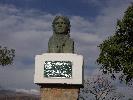
|
Women and Independence in Latin America An exploration of women's involvement in the Latin American Wars of Independence |

|

|
Women and Independence in Latin America An exploration of women's involvement in the Latin American Wars of Independence |

|
Click on the image below to see the full-size image
 Bartolina Sisa |
Other names: Bartholina Sisa
Gender:Female
Ethnic origen: Indigenous
Events:
| 1750 | - | Bolivia | - | Not applicable | - | She was born in Sicasica Province, (Bolivia). She was a resident of Caracato, Sicasica in 1781. |
| 1753 | - | Peru | - | Not applicable | - | Some sources say she was born August 24, 1753. |
| 1755 | - | Bolivia | - | Not applicable | - | Fisher gives her age as 26 in 1781. |
| 1781 | - | La Paz | - | Unknown | - | With her husband she led an indigenous uprising (the Túpac Amaru rebellion) against the Spanish in Bolivia at the head of an army of some 40,000 which laid siege to the city of La Paz in 1781 |
| 1782 | - | La Paz | - | Unknown | - | She was executed on 5 September 1782 in the Colonial Square (now Plaza Murillo). |
Connections:
Apaza familyBiography:
Born in Sicasica Province, (Peru?) in 1762, she fought alongside her husband, Julián Apaza (Túpac Kapari), for the independence of Upper Peru. She organised the siege of La Paz. (Pallis, 23.)
On 5 December 1782 Francisco Tadeo Diez de Medina ordered that she be taken to the Plaza Mayor, made to wear a crown of cuero y plumas. Her head and hands were cut off, and displayed in Cruzpata, Altos de San Pedro and Pampajasi, where she had operated. Later her head was taken to the pueblos of Ayooayo y Sapahagui, Sicasica province. (Guardia, 45)
O'Phelan claims she was hung on 5 September 1782 and that she was an Indian weaver from Caracato, Sicasica. (O'Phelan, 212, 309) During her trial she pointed out that she had been imprisoned five times because her husband had not been able to pay his tribute to the corregidor. (O'Phelan, 266)
In January 1980 a National Congress of Peasant Women formed a branch of the name Federación Nacional de Mujeres Campesinas de Bolivia "Bartolina Sisa" in recognition of her contribution. (Albó, 405)
She is listed as a washerwoman and seamstress in 1781. She was charged with ordering 2,000 troops to the siege of La Paz and hung in La Paz on 5 September 1782. (Campbell, 195)
Fisher describes her as a mestizo, who was aged 26 in 1781. (Fisher, 1966, 248)
She was sentenced to death by the same judge who tried Túpac Amaru. She was dragged to her execution tied to the tail of a horse, made to wear a leather crown and plumes. She carried a cross in her hand. She was then hanged and dismembered. (Fisher, 1966, 319)
References:
Ramb, Ana María (editor). (1999) Pasión y coraje: Mujeres que hicieron historia
Stern, Steve J. (editor). (1987) Resistance, Rebellion, and Consciousness in the Andean Peasant World, 18th to 20th Centuries
Campbell, Leon (1985) Women and the Great Rebellion in Peru, 1780-1783
Davies, Catherine, Brewster, Claire and Owen, Hilary (2006) South American Independence. Gender, Politics, Text
Fisher, Lillian Estelle (1966) The Last Inca Revolt
Guardia, Sara Beatriz (1985) Mujeres peruanas: El otro lado de la historia
O'Phelan Godoy, Scarlett (1985) Rebellions and Revolts in Eighteenth Century Peru and Upper Peru
Pallis, Michael (trans.) (1980) Slaves of Slaves: The Challenge of Latin American Women